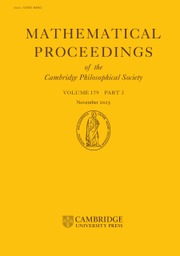No CrossRef data available.
Article contents
Uniform sets with few progressions via colourings
Published online by Cambridge University Press: 15 May 2025
Abstract
Ruzsa asked whether there exist Fourier-uniform subsets of  $\mathbb Z/N\mathbb Z$ with density
$\mathbb Z/N\mathbb Z$ with density  $\alpha$ and 4-term arithmetic progression (4-AP) density at most
$\alpha$ and 4-term arithmetic progression (4-AP) density at most  $\alpha^C$, for arbitrarily large C. Gowers constructed Fourier uniform sets with density
$\alpha^C$, for arbitrarily large C. Gowers constructed Fourier uniform sets with density  $\alpha$ and 4-AP density at most
$\alpha$ and 4-AP density at most  $\alpha^{4+c}$ for some small constant
$\alpha^{4+c}$ for some small constant  $c \gt 0$. We show that an affirmative answer to Ruzsa’s question would follow from the existence of an
$c \gt 0$. We show that an affirmative answer to Ruzsa’s question would follow from the existence of an  $N^{o(1)}$-colouring of [N] without symmetrically coloured 4-APs. For a broad and natural class of constructions of Fourier-uniform subsets of
$N^{o(1)}$-colouring of [N] without symmetrically coloured 4-APs. For a broad and natural class of constructions of Fourier-uniform subsets of  $\mathbb Z/N\mathbb Z$, we show that Ruzsa’s question is equivalent to our arithmetic Ramsey question.
$\mathbb Z/N\mathbb Z$, we show that Ruzsa’s question is equivalent to our arithmetic Ramsey question.
We prove analogous results for all even-length APs. For each odd  $k\geq 5$, we show that there exist
$k\geq 5$, we show that there exist  $U^{k-2}$-uniform subsets of
$U^{k-2}$-uniform subsets of  $\mathbb Z/N\mathbb Z$ with density
$\mathbb Z/N\mathbb Z$ with density  $\alpha$ and k-AP density at most
$\alpha$ and k-AP density at most  $\alpha^{c_k \log(1/\alpha)}$. We also prove generalisations to arbitrary one-dimensional patterns.
$\alpha^{c_k \log(1/\alpha)}$. We also prove generalisations to arbitrary one-dimensional patterns.
MSC classification
Information
- Type
- Research Article
- Information
- Mathematical Proceedings of the Cambridge Philosophical Society , Volume 179 , Issue 1 , July 2025 , pp. 79 - 103
- Copyright
- © The Author(s), 2025. Published by Cambridge University Press on behalf of Cambridge Philosophical Society
Footnotes
Supported by a Stanford Science Fellowship.
Supported by NSF CAREER Award DMS- 2044606 and a Sloan Research Fellowship.

